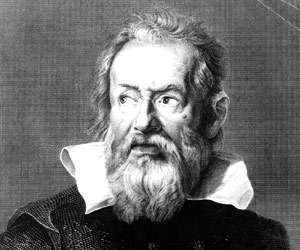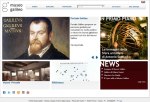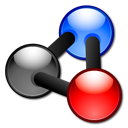Discounting air resistance, all bodies fall with the same motion; started together, they fall together. The motion is one with constant acceleration; the body gains speed at a steady rate
From this idea we get the equations of accelerated motion:
v = at and s = 1/2at2
where v is the velocity, a is the acceleration and s is the distance traveled in time t
The Greek philosopher ARISTOTLE (384-322 BC) was the first to speculate on the motion of bodies. He said that the heavier the body, the faster it fell.
It was not until 18 centuries later that this notion was challenged by Galileo.
The philosophers of ancient Greece had known about statics but were ignorant of the science of dynamics.
They could see that a cart moves because a horse pulls it, they could see that an arrow flies because of the power of the bow, but they had no explanation for why an arrow goes on flying through the air when there is nothing to pull it like the horse pulls the cart. Aristotle made the assumption that there must be a force to keep things moving. Galileo contradicted. He believed that something will keep moving at the same speed unless a force slows it down.
He contended that an arrow or a thrown stone had two forces acting upon it at the same time – ‘momentum’ pushes it horizontally and it only falls to the ground because the resistance of the air (a force) slows it down enough for it to be pulled to the ground by another force pushing downwards upon it; that which we now know as ‘gravity’.
This is the principle of inertia and led him to correctly predict that the path of a projectile is a parabola.
His insights were similar to the first two of the three laws of motion that Newton described 46 years later in ‘Principia’. Although he did not formulate laws with the clarity and mathematical certainty of Newton, he did lay the foundations of the modern understanding of how things move.
Galileo resisted the notion of gravity because he felt the idea of what seemed to be a mystical force seemed unconvincing, but he appreciated the concept of inertia and realized that there is no real difference between something that is moving at a steady speed and something that is not moving at all – both are unaffected by forces. To make an object go faster or slower, or begin to move, a force is needed.
Galileo would take a problem, break it down into a series of simple parts, experiment on those parts and then analyse the results until he could describe them in a series of mathematical expressions. His meticulous experiments (cimento) on inclined planes provided a study of the motion of falling bodies.
He correctly assumed that gravity would act on a ball rolling down a sloping wooden board that had a polished, parchment lined groove cut into it to act as a guide, in proportion to the angle of the slope. He discovered that whatever the angle of the slope, the time for the ball to travel along the first quarter of the track was the same as that required to complete the remaining three-quarters. The ball was constantly accelerating. He repeated his experiments hundreds of times, getting the same results. From these experiments he formulated his laws of falling bodies.
Mathematics provided the clue to the pattern – double the distance traveled and the ball will be traveling four times faster, treble it and the ball will be moving nine times faster. The speed increases as a square of the distance.
He found that the size of the ball made no difference to the timing and surmised that, neglecting friction, if the surface was horizontal – once a ball was pushed it would neither speed up nor slow down.
His findings were published in his book, ‘Dialogue Concerning the Two Chief World Systems‘, which summarised his work on motion, acceleration and gravity.
His theory of uniform acceleration for falling bodies contended that in a vacuum all objects would accelerate at exactly the same rate towards the Earth.
Legend has it that Galileo gave a demonstration, dropping a light object and a heavy one from the top of the leaning Tower of Pisa. Dropping two cannonballs of different sizes and weights he showed that they landed at the same time. The demonstration probably never happened, but in 1991 Apollo 15 astronauts re-performed Galileo’s experiment on the Moon. Astronaut David Scott dropped a feather and a hammer from the same height. Both reached the surface at the same time, proving that Galileo was right.
Another myth has it that whilst sitting in Pisa cathedral he was distracted by a lantern that was swinging gently on the end of a chain. It seemed to swing with remarkable regularity and experimenting with pendulums, he discovered that a pendulum takes the same amount of time to swing from side to side – whether it is given a small push and it swings with a small amplitude, or it is given a large push. If something moves faster, he realised, then the rate at which it accelerates depends on the strength of the force that is moving it faster, and how heavy the object is. A large force accelerates a light object rapidly, while a small force accelerates a heavy object slowly. The way to vary the rate of swing is to either change the weight on the end of the arm or to alter the length of the supporting rope.
The practical outcome of these observations was the creation of a timing device that he called a ‘pulsilogium’.
Galileo confirmed and advanced COPERNICUS‘ Sun centered system by observing the skies through his refracting telescope, which he constructed in 1609. Galileo is mistakenly credited with the invention of the telescope. He did, however, produce an instrument from a description of the Dutch spectacle maker Hans Lippershey’s earlier invention (patent 1608).
He discovered that Venus goes through phases, much like the phases of the Moon. From this he concluded that Venus must be orbiting the Sun. His findings, published in the ‘Sidereal Messenger‘ (1610) provided evidence to back his interpretation of the universe. He discovered that Jupiter has four moons, which rotate around it, directly contradicting the view that all celestial bodies orbited Earth, ‘the centre of the universe’.
‘The Earth and the planets not only spin on their axes; they also revolve about the Sun in circular orbits. Dark ‘spots’ on the surface of the Sun appear to move; therefore, the Sun must also rotate’
1610 – Galileo appointed chief mathematician to Cosmo II, the Grand Duke of Tuscany, a move that took him out of Papal jurisdiction.
1613 – writes to Father Castelli, suggesting that biblical interpretation be reconciled with the new findings of science.
1615 – a copy of the letter is handed to the inquisition in Rome.
1616 – Galileo warned by the Pope to stop his heretical teachings or face imprisonment.
1632 – when Galileo published his masterpiece, ‘Dialogue Concerning the Two Chief World Systems‘ – (Ptolemaic and Copernican) – which eloquently defended and extended the Copernican system, he was struggling against a society dominated by religious dogma, bent on suppressing his radical ideas – his theories were thought to contravene the teachings of the Catholic Church. He again attracted the attention of the Catholic Inquisition.
His book took the form of a discussion between three characters; the clever Sagredo (who argues for Copernicus), the dullard Simplicio (who argues hopelessly for Aristotle) and Salviati (who takes the apparently neutral line but is clearly for Sagredo).
In 1633 he was tried for heresy.
‘That thou heldest as true the false doctrine taught by many that the Sun was the centre of the universe and immoveable, and that the Earth moved, and had also a diurnal motion. That on this same matter thou didst hold a correspondence with certain German mathematicians.’
‘…a proposition absurd and false in philosophy and considered in theology ad minus erroneous in faith…’.
Threatened with torture, Galileo was forced to renounce his theories and deny that the Earth moves around the Sun. He was put under house arrest for the rest of his life.
After Galileo’s death in 1642 scientific thought gradually accepted the idea of the Sun-centered solar system. In 1992, after more than three and a half centuries, the Vatican officially reversed the verdict of Galileo’s trial.
Galileo’s thermoscope operated on the principle that liquids expand when their temperature increases. A thermoscope with a scale on it is basically a thermometer and in its construction Galileo was probably following directions given by Heron of Alexandria 1500 years earlier in ‘Pneumatics’. As with the telescope, Galileo is often incorrectly given credit for the invention of the thermometer.
Related sites
- The Galileo Project (galileo.rice.edu)
- Museo Galileo (www.imss.fi.it)
- Dialogue Concerning the Two Chief World Systems (calstatela.edu)
‘The Starry Messenger’ – Galileo (download pdf)
<< top of page

![0 N UMAX Mirage IIse V1.0 [4] Drawing by GALILEO of the surface of the moon](https://geoffneilsen.files.wordpress.com/2012/06/galileo500x478.jpg?w=150&h=143)

 TIMELINE
TIMELINE
